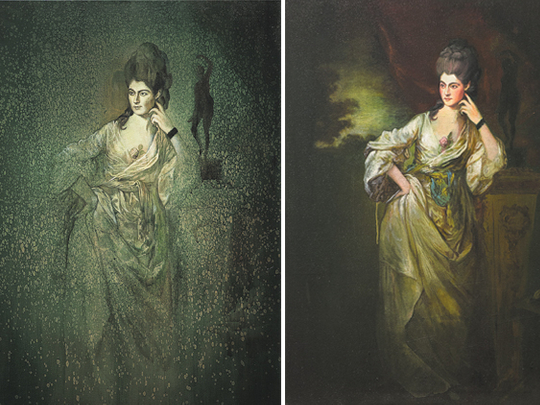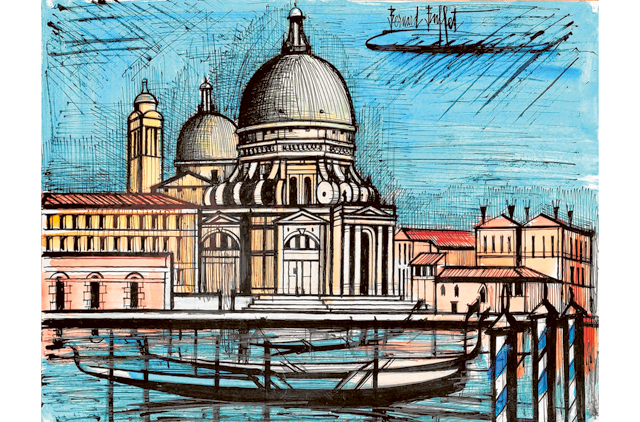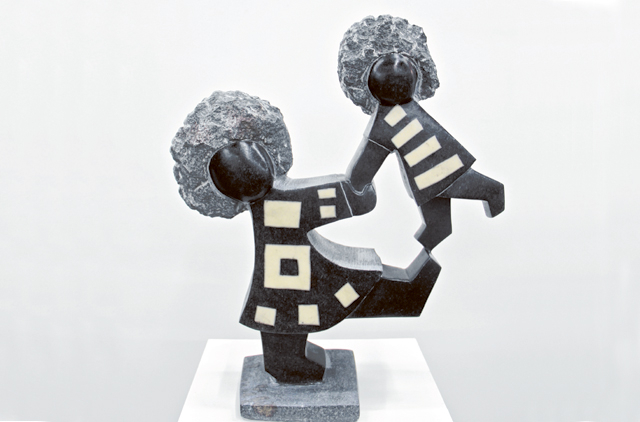
The paintings in British artist Ross Chisholm’s first solo exhibition in Dubai, titled ‘Testament’, are based on society portraits from the early days of the industrial revolution in Britain, but presented with a modern twist. In an earlier work, Chisholm has distorted traditional portraits and photographs from the 1970s, by interventions such as injecting geometric abstraction and combining figures from different centuries. In his latest body of work he continues his experiments with realism and abstraction. His paintings decontextualise historical images and trace the process of decay and restoration of art, opening up dialogues of dislocated histories and ambiguous identities.
Chisholm’s paintings appear to be in a state of flux between the process of construction, deconstruction and reconstruction. On some canvases, portraits inspired by the paintings of 18th-century British artists such as Thomas Gainsborough and Joshua Reynolds are visible beneath new gestural strokes; while in others they are completely obliterated by abstract forms and vaguely look like human figures. Some works are presented as triptychs documenting the changes from a detailed classical society portrait done with a fine brush, to a faded image that ultimately dissolves into a flurry of gestural strokes.
“In the art world there is a lot of discussion about reality and abstraction in painting. My work raises questions about whether what you are seeing are portraits or purely abstract paintings, thus presenting a playful ‘testament’ to the nebulous nature of this discourse,” Chisholm says.
The artist’s work has been influenced by his visits to the conservation departments of museums, and it essentially captures the journey of a work of art, and of art itself, through time. “When you look at X-rays of 18th-century portraits you can see the many layers of the original compositions as well as the underlying abstraction from which the figure emerged. The act of conserving a piece of art is interesting because it involves reconstructing a work hundreds of years after it was originally created, and long after the artist is gone. It makes you realise that a painting continues to change over time, as the original composition deteriorates and is then restored by new hands for a new audience. I love this idea of temporality and want to express it through my work. But I am also making these works timeless by removing the original portraits from narratives and contexts, and putting them in a contemporary context,” he says.
Jyoti Kalsi is an arts enthusiast based in Dubai.
“Testament” will run at Green Art Gallery, Al Quoz, until March 10.
Sculptures of happy children
Zimbabwean sculptor Dominic Benhura is UNICEF’s “artist of the year”, and the opal, spring stone, and dolomite sculptures in his latest show in Dubai have been featured on UNICEF’s calendar for 2014.
Benhura has created public sculptures for various prestigious venues around the world, and has played a pioneering role in transforming the traditional Shona stone sculpture of Zimbabwe (named after the Shona tribe) into an internationally recognised modern art. The artist takes inspiration from nature, family and his relationship with his children to create sculptures with simple lines that convey a sense of movement and physical and emotional balance. This show features sculptures of children in various playful poses such as doing cartwheels or swinging on their parents’ arms. The artworks convey the joy and exuberance of the children and the bond with their parents. “I try to express emotion through form rather than facial expression. I leave the facial features undefined to depict the universality of humanity,” the artist says.
The exhibition will run at Showcase gallery, Al Quoz, until March 15.
–Jyoti Kalsi
French masterpieces
Opera Gallery’s latest show, “Bernard Buffet and Auguste Rodin”, celebrates the work of two French masters who revolutionised the idea of figurative art in the 19th and 20th centuries.
Rodin (1840-1917) is recognised as the most remarkable sculptor of the 19th century. His innovative techniques and depiction of the human figure, with emphasis on movement, paved the way for the development of modern sculpture. His most famous public sculptures include “The Burghers of Calais”, “The Kiss”, “Balzac” and “The Gates of Hell.”
The show offers art lovers a rare opportunity to view and acquire some of his most significant works such as “The Thinker”, “Balzac”, “The Minotaur”, the expressive “hands” that the artist created throughout his career, and several studies of dance movements. The casts are reproductions from the original plasters, bearing the sculptor’s signature, and their authenticity has been certified by the Rodin Museum in Paris.
Buffet (1928–1999) believed that “abstract painting is limited and boring, while figurative art is unlimited”. He painted landscapes, portraits, still lifes and religious themes. During the 1950s he was the leading figurative artist in Paris, and became a celebrity at the age of 21. Unable to paint any longer due to Parkinson’s disease, the artist committed suicide in 1999.
Buffet was known for the thick black outlines he used in his work, and the elongated body forms and intense expressions of his figures. The oil, water-colour and mixed-media paintings in this show trace his career from the 1950s to the 1990s, and include significant works such as his coastal and Riviera scenes, still lifes of flowers, and signature clowns.
“Rodin is one of the greatest sculptors of our times. Similarly, Buffet is the most important postwar artist in France. But despite his international fame, his work is undervalued in the market, which makes it a good investment for collectors. We are happy to bring important works by these French masters to Dubai, a city that understands and appreciates art,” says Gilles Dyan, chairman and CEO of Opera Gallery.
“Bernard Buffet and Auguste Rodin” will run at Opera Gallery Dubai, DIFC, until March 1.
–Jyoti Kalsi













